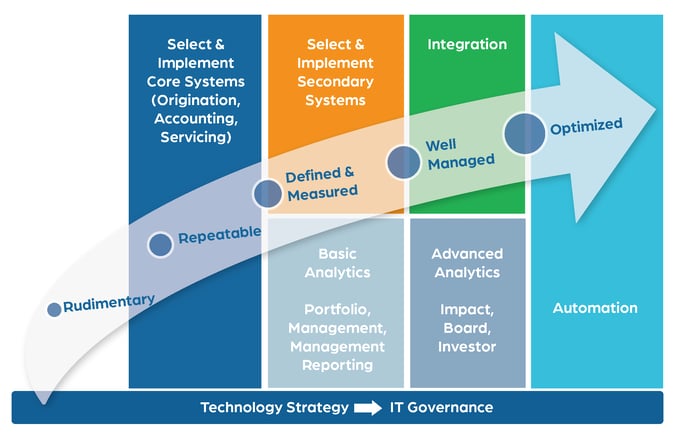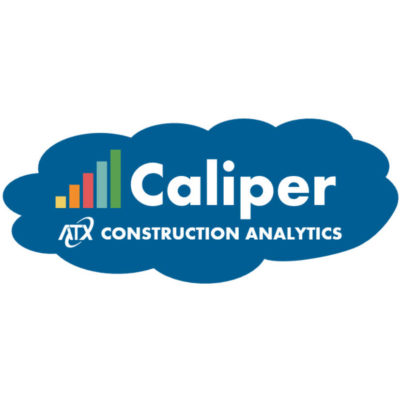Author: Mark DiGiovanni
Does your Community Development organization struggle with efficiently managing day-to-day operations or making sense of all the data you collect? The cause could be that the maturity of your business operations has jumped ahead of your technology maturity. As organizations expand their impact and constituent base with growth, many discover they simply don’t have the technology tools to run things as efficiently as they used to.
This often occurs as organizations grow and expand products and services. Community Development organizations are often small but complex compared to other businesses. There is often an entrepreneurial spirit that drives the creation of needed products and services coupled with reporting requirements for many different audiences. Most organizations find they are not capable of managing all of their data in a single platform and often need to rely heavily on Excel to fill gaps as the business expands. To keep up, they also need to deploy more sophisticated origination and CRM solutions along with robust loan servicing platforms.
From there, efficiently managing continued growth requires the integration of these systems to maximize process efficiency and to use data to its full potential. The next phase often includes the deployment of powerful reporting and analytics tools to meet the demands of compliance, impact, board, and investor reporting. Only then can managers effectively access and leverage the key performance indicators that enable strong business decision-making.
The final step—based on today’s available technologies—involves fully optimizing business processes. This is where advanced technologies such optical character recognition, prescriptive analytics, and robotic process automation may come into play.
Assessing Your Technology Maturity
So perhaps it’s time to take a step back and assess the technology maturity of your organization. Here are the five stages that organizations typically go through in order to keep executing business processes efficiently as they grow:

- Stage 1 (Rudimentary) consists of very few digital processes. The organization executes functions based on individual effort. Accounting and management are supported by simple technology solutions such as Excel spreadsheets and online banking accounts. Basic accounting and loan servicing systems may also exist but processes like origination and underwriting operate outside of systems in a non-secure environment with limited controls over data. Reporting is manual and reactive to requests.
- Stage 2 (Repeatable) involves basic processes that can be repeated for similar tasks, such as the deployment of a multi-user accounting solution to manage common transactional processes along with the deployment of a CRM platform for loan pipeline management. Managers can now run reports to analyze financial, pipeline and portfolio data from within these source systems. The business may also deploy isolated point solutions to help manage application intake, underwriting, or technical assistance. Basic reporting packages exist relying on manual effort.
- Stage 3 (Defined and Measured) kicks off the phase to precisely define standardized and consistent processes. Security and controls are a strong focus along with the development of standard operating procedures. Data fields and measures to be used in reporting are defined as well as the processes to collect that data. This stage also integrates accounting and loan servicing solutions with other enterprise solutions such as CRM, application software, and technical assistance tracking. Descriptive reporting exists to help tell the organizations gain insight into their performance with impact reporting focusing on output data.
- Stage 4 (Well Managed) brings in strategic analysis powered by business intelligence. Here data from the core applications is aggregated into a centralized analytics platform to monitor underwriting processes, portfolio performance, compliance, and impact. Survey solutions are deployed to collect outcome data along with the collection of external data sets. This enables your organization to quantify key performance indicators and meet the reporting requirements of institutions, investors, and the communities you serve. Advanced analytics allow the organization to view trend data, compare data from multiple platforms, visualize information, and forecast future performance. The business now has real-time access to vital information to measure the quality of processes and to speed up decision-making.
- Stage 5 (Optimized) sees the introduction of the next level of predictive and prescriptive analytics, optical character recognition to parse client documents, and the deployment of advanced workflow solutions including robotic process automation. Your organization has the appropriate tools in place to monitor performance and operations to run faster and more efficiently, so you can close more loans and better implement your mission to the communities you serve.
Maturity Takes Time
It is common for companies to want to skip one or more of the stages. They see the magic that other companies can wield using AI and think, “We can do that too!” But you can’t fully get to Stage 5 until you complete the steps before - and in the proper order - as the organization and its processes often need to mature to these advanced levels.
Effectively leveraging technology requires a certain level of patience, and realizing, like a farmer, that you can’t just jump ahead to the harvest. You must carefully plan, sow the seeds, and then nurture your technology as you progress from Stage 1 through Stage 4, in order. Then, you will be ready for Stage 5.
Full Technology Maturity Not Necessarily Required
Also, consider that not every organization needs to evolve through all five stages in rapid succession. Depending on your business model and the size of your company, Stage 3 or Stage 4 might be the furthest you need to travel in the current state of your business. There are also industry gaps in available technology and budget constraints which may limit the full realization of Stage 5.
This is why it’s important to align your business road map to your technology road map. Making sure the two stay coordinated will allow you to run your organization efficiently in the short term. You can also project what is coming in the future and determine if and when it will be time to take the next step.
To find out where your organization stands today across the technology maturity spectrum contact us for assistance in comparing your current technology maturity to your operations maturity. You can also reach out to me directly at mark.digiovanni@atxadvisory.com




